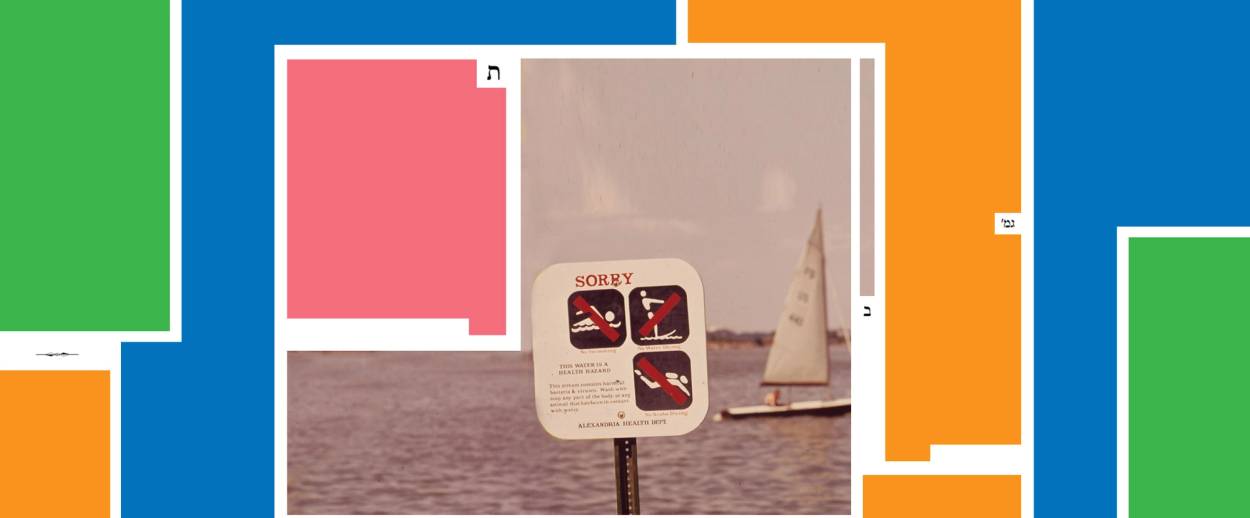Burden of Proof
In this week’s ‘Daf Yomi,’ the rabbis spin out all the hypotheticals—and then some—from a few simple verses from Exodus about open pits and a goring ox to see who might be at fault when things go wrong




Literary critic Adam Kirsch is reading a page of Talmud a day, along with Jews around the world.
Most legal systems are drawn up in the form of elaborate codes, with sections covering every technicality and eventuality that might occur. Biblical law, however, is very different: It usually takes the form of brief, concrete examples, miniature narratives. Take the case of the goring ox from Exodus, which has been at the foundation of Tractate Bava Kamma. It implies a basic principle of fairness, which is that the owner of livestock is obligated to take reasonable precautions to prevent them from causing damage or injury. But the principle is only implied, not stated. It is up to the rabbis of the Talmud to make the implication explicit, and in the process to supply halakhah with the abstract principles needed to give the law flexibility and consistency.
One such principle familiar from American law is “burden of proof.” Nothing like this expression can be found in the Bible, but it is bound to come up in many kinds of civil disputes. Take, for instance, the case in the mishna in Bava Kamma 46a: An ox kills a cow, and when the carcass is discovered, there is a dead newborn calf by its side. There are two possibilities: either the calf was born before the mother was gored and it just happened to die, or the cow was pregnant when it was gored, and the fetus was killed and born dead. If the latter happened, then the owner of the ox is liable for the price of both the cow and the calf, since his ox killed them both. If it was the former, then the owner of the ox is liable only for the price of the cow, not the calf. But who has the burden of proof? Is it up to the cow’s owner to prove that the cow was still pregnant, or is it up to the ox’s owner to prove that the calf had already been born and then died for some other reason?
The answer comes in the Gemara, where the rabbis lay down the standard for burden of proof in civil cases. “The Rabbis say this is the significant principle of law: The burden of proof rests upon the claimant.” Since the owner of the cow is the one claiming compensation, he is the one who must prove the facts of the case. The same principle applies, the Gemara goes on to explain, in a case where there is a dispute about the sale of an ox who turns out to be a goring ox. In this case, the buyer might come to court demanding that the transaction be canceled, since a goring ox cannot be used for field work (it might gore one of the other oxen). But the seller might then reply that the buyer never intended to use the ox for labor; rather, it was sold to be slaughtered for its meat, and for that purpose a goring ox is acceptable. Who has the burden of proof? The Gemara goes back and forth through several possible answers, but ends up reiterating the same principle: The burden of proof rests upon the claimant, which in this case means the buyer.
Another set of issues concerning oxen is raised in the next mishna, which addresses a case in which a visitor to another’s home has his property destroyed by his host’s ox. Say, for example, a vendor of pots enters a courtyard in which there is an ox, and the ox breaks his pots. Is the owner of the ox liable, since his ox did the damage, or is the vendor liable, since he voluntarily entered a private domain where he knew there was an ox?
The answer here turns out to depend on permission. If the homeowner gave the vendor permission to enter, then he assumes the responsibility to safeguard his ox. If, on the other hand, the vendor entered uninvited, then he assumes the risk, and if the pots are broken it is his own fault. This example reminded me of the now-legendary case of Bodine v. Enterprise High School, in which a burglar sued a school for injuries he sustained when he fell through a skylight while robbing it. That case, from 1982, became a notorious example of criminal chutzpah, though the burglar, Bodine, never actually prevailed in court. In Talmudic law, there seems to be no doubt that Bodine would have lost: Because he didn’t have permission to enter the school, the school never assumed liability for his injuries.
Or perhaps that case would have fallen under a different category of Jewish law: not Ox, which deals with injuries caused by a living creature, but Pit, which deals with injuries caused by stationary objects. Pit cases came to the fore in Chapter Five of Bava Kamma, as the rabbis once again used a basic biblical premise to deduce more abstract principles. According to Exodus, if a man digs an open pit and a donkey falls in it, the digger must pay damages to the donkey’s owner, since he created a public hazard. But this raises some obvious questions: For instance, how do you define a pit? How deep does a hole have to be before it becomes a dangerous pit? The answer the rabbis give is 10 handsbreadths (tefachim). Since a tefach is about 3.5 inches, this means a pit has to be 3 feet deep to qualify as a lethal danger.
This seems straightforward enough, but the rabbis, as always, find ingenious ways to test the rule. If you are liable for digging a pit 10 tefachim deep, what about if you build a mound 10 tefachim high and a cow falls off it? In this case, you are still responsible for causing a cow to fall the same distance, only it is falling above ground, not below ground. Is this a legally salient distinction? The answer turns out to depend on what the actual cause of death is when a cow falls in a pit. If it is killed by the sheer impact, then a mound should be as culpable as a hole. This is the position held by Rav in the Gemara on Bava Kamma 50b.
But Rav’s great antagonist, Shmuel, has an alternative explanation, based on what seems to be unsound premodern science. A cow that falls in a pit, Shmuel says, is actually killed by the “lethal fumes” that gather at the bottom of the pit—exhaled, presumably, from the bowels of the earth. In this case, then, a mound is not as dangerous as a pit, because the mound does not produce lethal fumes. The theory of fumes, in turn, generates another set of complications, having to do with the presence of water in the pit. Ordinarily, according to Rabba bar bar Chana, a handsbreadth of water is considered to be equivalent to two handsbreadths of depth, for the purpose of calculating risk: Thus, a pit that is only 8 tefachim deep but contains 2 tefachim of water is considered sufficiently deep so as to be deadly. But if it is the fumes that are responsible for killing, does this still hold? Does a pit of 8 tefachim release the same amount of fumes as one of 10 tefachim? Here the rabbis throw up their hands, using the formula teiku, “it shall stand unresolved.”
Another kind of complication has to do with a pit that is dug by two different people. Say the first person digs a pit that is only 9 tefachim deep, but then a second person comes along and digs another tefach at the bottom, rendering it a legal hazard. If an ox falls in and dies, which of the diggers is responsible? One might think that they should share the liability; perhaps the first digger should bear 90 percent of the cost, since he dug 90 percent of the pit.
But this is not the Talmudic response. On the contrary, the Talmud assigns the entire liability to the second digger, since he was the one who converted a legally innocent hole into a legally culpable pit. After all, the Biblical verse says “if a man shall open a pit”—“one man but not two,” the Gemara explains, suggesting that only one person can be responsible. Yet this principle does not seem to hold in another hypothetical case. If one man digs a pit 10 tefachim deep, and a second man comes and digs it deeper so it is now 20 tefachim deep, who is responsible for it? One might think that, by the same logic, the first man is wholly responsible, since he is the one who created a legal hazard; after all, if a pit is already considered deadly, it shouldn’t become any more deadly if it gets deeper. But the Gemara says the opposite: In such a case, both diggers share liability.
And what if a pit is 9 tefachim deep, and then someone comes along and raises the rim of the pit by 1 tefach, so that it is now 10 deep? Who is liable in that case? And what if a pit is covered, but the cover rots from the inside? And what if the cover is strong enough to keep out oxen, but then a camel stands on it and falls in? So the discussion goes on, one hypothetical following the next, in a way that the Bible writers probably never anticipated. It is a pleasure to see the Rabbis of the Talmud draw so much water from the Torah’s narrow well.
***
To read Tablet’s complete archive of Daf Yomi Talmud study, click here.
Adam Kirsch is a poet and literary critic, whose books include The People and the Books: 18 Classics of Jewish Literature.